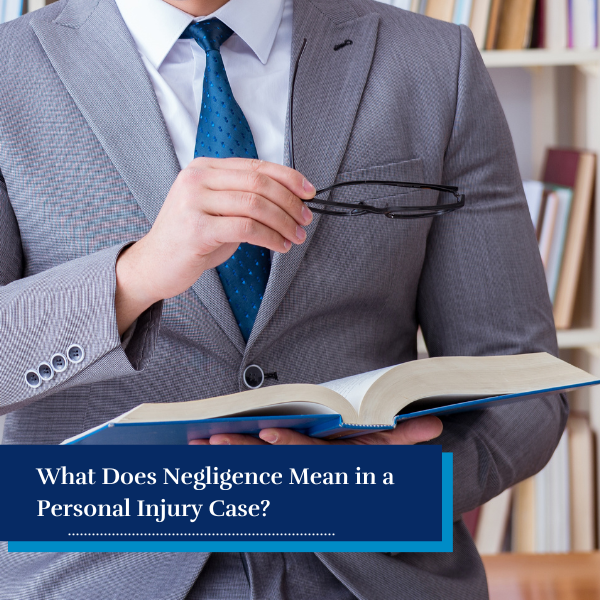
A person is negligent when they fail to exercise a “reasonable duty of care” toward others. There are four elements to a negligence claim: (1) duty, (2) breach, (3) causation, and (4) damages. Let’s look at each of these elements in more detail.
Elements of Negligence in a Personal Injury Claim
So, what is a “reasonable duty of care?” Basically, it’s the level of care a reasonable person would be expected to exercise toward others in any given circumstance. For example, a driver’s duty of care is to obey traffic laws and avoid causing harm to other motorists, bicyclists, or pedestrians. A store owner’s duty of care is to ensure that the premises are free from foreseeable hazards and to remove any hazards within a reasonable amount of time. Failure to exercise reasonable care in any of these scenarios is considered a “breach” of one’s duty of care.
However, to have a successful negligence claim, it’s not enough for a plaintiff to prove that a defendant breached their duty of reasonable care. The plaintiff must also prove that the defendant’s breach of care caused injuries to the plaintiff.
There are two types of causation:
- “Actual cause” — Actual cause is present when the facts of the case indisputably prove that the defendant’s breach of care directly caused the plaintiff’s injuries. For example, if a driver is speeding and hits a pedestrian who is already in the middle of a crosswalk, the facts prove that the driver’s breach of care directly caused the pedestrian’s injuries.
- “Proximate cause” — Causation is not always so straightforward, however. In many cases, the plaintiff must prove proximate cause. This is when the plaintiff’s injuries were not directly caused by the defendant’s breach of care but were the foreseeable result of the defendant’s negligence. For example, if the defendant rear-ended the plaintiff and that night the plaintiff started suffering from migraines, the plaintiff would have to prove that the migraines were the foreseeable result of the accident rather than some other factor such as stress or illness. Injuries or symptoms that are not immediately present or visible at the time of the breach of care are typically harder to prove and require more legal attention.
Types of Negligence in Personal Injury Claims
You should also be aware that there are three types of negligence:
- Ordinary negligence — Ordinary negligence is a simple failure to exercise a reasonable duty of care. For example, a driver who looks down at their phone and rear-ends another vehicle at a stop sign is guilty of ordinary negligence.
- Gross negligence — Gross negligence is a breach of the duty of care in which the defendant should have reasonably foreseen the harm that would occur. A driver who tries to pull around a stopped school bus while children are getting off the bus commits gross negligence.
- Negligence per se — Negligence per se is negligence as a matter of law. It occurs when the defendant’s conduct is not only negligent but also breaks the law. For instance, this would include a driver who runs a red light. Therefore, the school bus example above is an example of both gross negligence and negligence per se.
North Carolina’s Contributory Negligence Law
One important item to remember when thinking about causation is that North Carolina is one of only a few “contributory negligence” states. This means that if a plaintiff is determined to be even one percent at fault for an accident, the plaintiff will be unsuccessful in recovering damages from a defendant. For example, if a defendant made a left turn in front of a plaintiff, but the plaintiff was speeding, the plaintiff would not have a successful case due to the doctrine of contributory negligence.
Damages Available in a North Carolina Personal Injury Claim
If a plaintiff is able to prove that a defendant breached their duty of reasonable care and that such breach either directly or proximately caused the plaintiff injuries, then the plaintiff may be able to recover damages (basically a legal term for money).
In North Carolina, there are two types of damages:
- Compensatory — Compensatory damages can be broken down into economic and non-economic damages. Economic damages may include compensation for medical bills, lost wages, and property loss. Non-economic damages may include compensation for pain and suffering, permanent impairment due to your injury, emotional distress, and other consequences of your injury that cannot be easily given a financial value.
- Punitive — Punitive damages can play a role in negligence cases and are only awarded if the defendant’s conduct was willful and egregious. For example, punitive damages may apply when an at-fault driver is intoxicated at the time of the accident.
Contact a North Carolina Personal Injury Lawyer Today
Trying to wade through a negligence case on your own can be overwhelming and confusing. The Durham personal injury lawyer here at Kreger Brodish is ready to shoulder the burden of your legal case while you recover from your injuries and spend time with your family. We have the skill and experience to investigate the incident and work to prove negligence and causation to obtain for you the compensation you deserve. Call us today for your free consultation.







